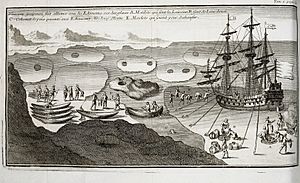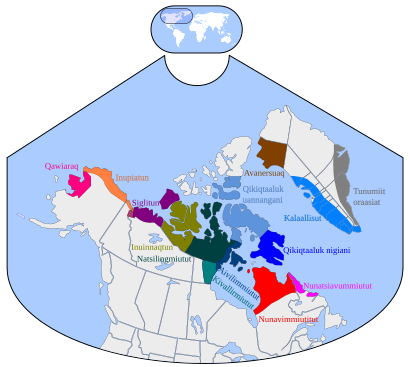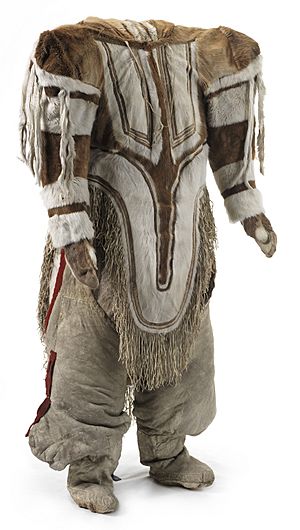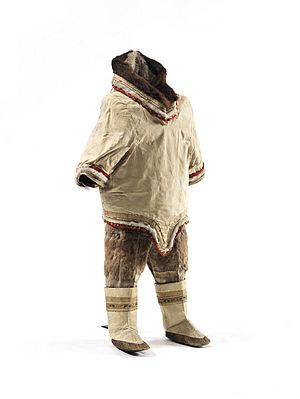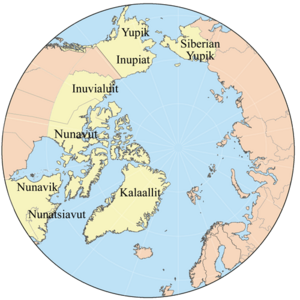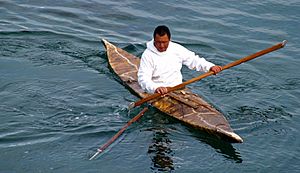Inuit facts for kids

Igloolik Inuit women and child in traditional parkas (1999)
|
|
| Total population | |
|---|---|
| 154,378 | |
| Regions with significant populations | |
| Canada | 70,540 (2021) |
| Greenland | 50,787 (2017) |
| Denmark | 16,470 (2018) |
United States
|
16,581 (2010) |
| Languages | |
|
|
| Religion | |
| Christianity, Inuit religion | |
| Related ethnic groups | |
| Aleut, Yupik, Indigenous people of the Americas | |
Inuit are a group of indigenous peoples that live in the Arctic and subarctic regions of Greenland, Labrador, Quebec, Nunavut, the Northwest Territories, and Alaska. Europeans and others called them Eskimo for years, but the Inuit think this term is offensive. The term inuit means "the people or "the real people."
Inuit languages are part of the Eskimo–Aleut languages. These languages are also known as Inuit-Yupik-Unangan and Eskaleut.
History
Pre-contact history
Inuit are the descendants of the Thule people, who emerged from western Alaska around A.D. 1000. In Canada and Greenland, almost all Inuit lived north of the "arctic tree line." The most southern "officially recognized" Inuit community in the world is Rigolet in Nunatsiavut. It is located in the northern part of Newfoundland and Labrador in Canada.
After about A.D. 1350, the climate grew colder during the period known as the Little Ice Age. The Little Ice Age did not affect the Alaskan Inuit much. They were still able to continue their whaling. However, Inuit who lived in the high Arctic were forced to move south and change their way of life, which revolved around the materials they got from whales.
Their first European contact was with the Vikings who had settled in Greenland centuries prior. Viking sagas talk about meeting the Inuit, whom they called Skræling.
Post-contact history
Early contact with Europeans
In 1576, Martin Frobisher, while searching for the Northwest Passage, found the Inuit. Inuit oral tradition says that five of Frobisher's crew lived among them willingly for a few years. They died, however, trying to leave Baffin Island in a self-made boat. Frobisher, while looking for his men, captured three Inuit and brought them back to England. They were possibly the first Inuit ever to visit Europe.
The semi-nomadic Inuit were fishermen and hunters harvesting lakes, seas, ice platforms, and tundra. Some stories say that the Inuit were hostile toward early French and English explorers, fishermen, and whalers. However, others say they traded and were peaceful with them. The Europeans brought infectious diseases with them, causing many Inuit to die.

20th century
As the Canadian population grew, the government of Canada and entrepreneurs began to expand north, especially the fur and mineral-rich hinterlands (areas that were uncharted and near the coast). By the late 1920s, there were no longer any Inuit who had not been contacted by traders, missionaries, or government agents. In 1939, the Supreme Court of Canada found, in a decision known as Re Eskimos, that Inuit should be considered Indians and were thus under the jurisdiction of the federal government.
Native customs were worn down by the actions of the Royal Canadian Mounted Police (RCMP), who enforced Canadian criminal law on Inuit. The Inuit did not understand the rules of the Canadians.
In the 1950s, the Government of Canada began what was called the High Arctic relocation. Families were moved to the far northern part of the Arctic with the promise that they could keep their traditional way of life. They were left without enough supplies but eventually learned how to survive. The Canadian government began to actively settle Inuit into permanent villages and cities, occasionally against their will. Inuit children also began attending the local public schools. Many Inuit said that Canadian education taught foreign values that went against the traditional structure and culture of Inuit society.
By the 1960s and 1970s, Inuit began to become politically active. They fought for land claims. Finally, in 1999, the new territory of Nunavut was set aside for a population that would be mostly Inuit.
Cultural history
Languages
Inuit speak Inuinnaqtun, Inuktitut, Inuvialuktun, and Greenlandic languages, which belong to the Inuit-Inupiaq branch of the Inuit-Yupik-Unangan language family. The Greenlandic languages are divided into: Kalaallisut (Western), Inuktun (Northern), and Tunumiit (Eastern).
Inuit in Alaska and Northern Canada also typically speak English. In Greenland, Inuit also speak Danish and learn English in school. Canadian Inuit may also speak Québécois French.
Diet
The Inuit have traditionally been fishermen and hunters. They still hunt whales (especially bowhead whale), seal, (especially ringed seal, harp seal, common seal, bearded seal), polar bears, muskoxen, birds, and fish. Inuit diets are made of mostly healthy fats (about 75%) and protein.
While it is not possible to grow plants for food in the Arctic, the Inuit have traditionally gathered those that are naturally available. Grasses, tubers, roots, plant stems, berries, and seaweed (kuanniq or edible seaweed) were collected and preserved depending on the season and the location.
Tattoos
The ancient art of face tattooing among Inuit women, which is called kakiniit or tunniit in Inuktitut, dates back nearly 4,000 years. The traditional method of tattooing was done with needles made of sinew or bone soaked in suet and sewn into the skin, but today they use ink.
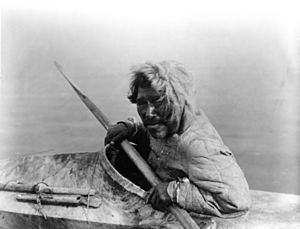
The Inuit hunted sea animals from single-passenger, seal-skin covered boats called qajaq, or kayaks. Inuit also made umiaq ("woman's boat"), larger open boats made of wood frames covered with animal skins, for transporting people, goods, and dogs.
Dogs were an important part of Inuit life. In winter, both on land and on sea ice, the Inuit used dog sleds (qamutik) for transportation. They also protected the Inuit villages by barking at bears and strangers. The Canadian Eskimo Dog, the Greenland Dog, the Siberian Husky, and the Alaskan Malamute are common dogs of the area. Today, Inuit use snowmobiles for travel as well.
Industry, art, clothing, and shelter
The Inuit used what they could find in their habitat for industry. Animal hides, driftwood, bones, and stones were used to make tools and weapons. They found and used the Cape York Meteorite as a source of iron.
Art played a big part in Inuit society and continues to do so today. Small sculptures of animals and human figures, usually showing everyday activities such as hunting and whaling, were carved from ivory and bone. In modern times, Inuit use soft stone to make prints and carved figures.
Inuit dress in thick, warm clothing and footwear to survive the cold weather. Traditional Inuit clothing and footwear is made from animal skins and furs, sewn together using needles made from animal bones and threads made from other animal products, such as sinew. The parka is called an anorak and boots are called mukluk or kamik.
Inuit people lived in a temporary shelter made from snow called an igloo. When temperatures were above freezing, they lived in tents, known as tupiq, made of animal skins supported by a frame of bones or wood. Some used driftwood, while others built sod houses.
Gender roles, marriage, birth, and community
Traditionally, men were the hunters and fishermen, and the women took care of the home and children. However, sometimes women would hunt and women would be expected to know how to sew and cook.
The Inuit did not have a formal ceremony or ritual for marriage. Men could have one or more than one wife and extended families could all live together. Men were usually married around the time they became good hunters, and women were usually married when they became old enough to have children.
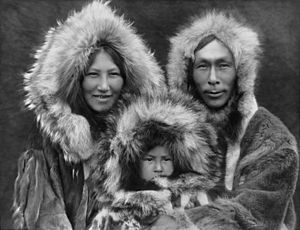
One of the customs following the birth of an infant was for an Angakkuq (shaman) to place a tiny ivory carving of a whale into the baby's mouth, in hopes this would make the child good at hunting. Loud singing and drumming were also customary at birth.
Inuit families depended on others in their community for survival. Goods were shared within a household and within the whole community.
Traditional law
Inuit Qaujimajatuqangit or Inuit traditional laws had a set way of doing things that had to be followed. They had three laws: “Maligait” is what is to be followed, “Piqujait” is what has to be done, and “Tirigusuusiit” is what needs to be avoided.
Traditional beliefs
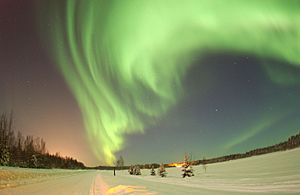
The environment in which the Inuit lived inspired a mythology filled with adventure tales of whale and walrus hunts. Long winter months of waiting for caribou herds or sitting near breathing holes hunting seals gave the Inuit time to tell stories, or myths, about great adventures and the mysterious and sudden appearance of ghosts and fantastic creatures.
The Inuit believed that the causes of disease were of a spiritual origin. An “angakkuq,” or shaman, was considered to have a connection with spirits in the Inuit community. He was also thought of as a "medicine man" who could help heal people who were sick because of the spirits. Inuit religion involved many rituals.
Governance
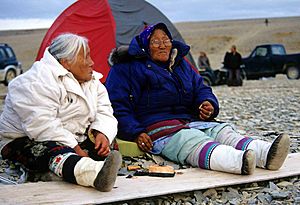
The Inuit govern themselves as much as they can. Elders are important in the communities.
The Inuit Circumpolar Council is one of the six groups of Arctic indigenous peoples that have a seat as a so-called "Permanent Participant" on the Arctic Council. This council involves eight Arctic Countries (USA, Canada, Russia, Denmark, Iceland, Norway, Sweden, and Finland) that discuss Arctic policy.
Modern culture
Inuit art such as soapstone carvings is one of Nunavut's most important industries. Carving, printmaking, textiles, performing arts, and Inuit throat singing are very popular among the Inuit community. Canada has adopted some of the Inuit culture as national symbols. Storytelling, mythology, music, and dancing remain important parts of the culture. Family and community are very important. The Inuktitut language is still spoken in many areas of the Arctic and is common on radio and in television programs.
Inuit celebrate their traditional New Year, called Quviasukvik. The Arctic Winter Games, is held in communities across the northern regions of the world. Traditional Inuit and northern sports are part of the events.
With current dependence on modern society for necessities, (including governmental jobs, food, aid, medicine, etc.), the Inuit have interacted more and more with people whose societal norms are different than the Inuit culture.
Interesting facts about Inuit
- Inuit Sign Language is a dying language. Only about 50 people today are known to still speak it.
- Inuktitut is one of the most spoken languages of the Inuit people.
- A member of an Inuit community is called an “Inuk.”
- Many Inuit people believed that the spirits of their ancestors could be seen in the lights of the aurora borealis (also known as the Northern Lights).
- Kayaks, snowshoes, and snow googles are all Inuit inventions.
- The ancient Inuit made armor from walrus teeth.
- Inuksuk are human figures built from piled stones that seem to defy gravity.
- The qamutik is a sled designed to carry heavy loads over densely packed snow and rough terrain.
- The Inuit people eat kelp, caribou liver, and seal brain raw to get all of the vitamins and minerals from them.
- Most of Greenland's population (about 89%) is Inuit.
- The word igloo means any type of structure where people live.
See also
 In Spanish: Inuit para niños
In Spanish: Inuit para niños


